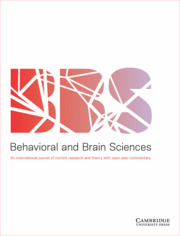Article contents
Suboptimality in perceptual decision making
Published online by Cambridge University Press: 27 February 2018
Abstract
Human perceptual decisions are often described as optimal. Critics of this view have argued that claims of optimality are overly flexible and lack explanatory power. Meanwhile, advocates for optimality have countered that such criticisms single out a few selected papers. To elucidate the issue of optimality in perceptual decision making, we review the extensive literature on suboptimal performance in perceptual tasks. We discuss eight different classes of suboptimal perceptual decisions, including improper placement, maintenance, and adjustment of perceptual criteria; inadequate tradeoff between speed and accuracy; inappropriate confidence ratings; misweightings in cue combination; and findings related to various perceptual illusions and biases. In addition, we discuss conceptual shortcomings of a focus on optimality, such as definitional difficulties and the limited value of optimality claims in and of themselves. We therefore advocate that the field drop its emphasis on whether observed behavior is optimal and instead concentrate on building and testing detailed observer models that explain behavior across a wide range of tasks. To facilitate this transition, we compile the proposed hypotheses regarding the origins of suboptimal perceptual decisions reviewed here. We argue that verifying, rejecting, and expanding these explanations for suboptimal behavior – rather than assessing optimality per se – should be among the major goals of the science of perceptual decision making.
Keywords
Information
- Type
- Target Article
- Information
- Copyright
- Copyright © Cambridge University Press 2018
Footnotes
Authors D. Rahnev and R. N. Denison contributed equally to this work.
References
- 168
- Cited by


Target article
Suboptimality in perceptual decision making
Related commentaries (27)
Although optimal models are useful, optimality claims are not that common
Bayesian statistics to test Bayes optimality
Characterising variations in perceptual decision making
Credo for optimality
Descending Marr's levels: Standard observers are no panacea
Discarding optimality: Throwing out the baby with the bathwater?
Excess of individual variability of priors prevents successful development of general models
How did that individual make that perceptual decision?
Identifying suboptimalities with factorial model comparison
Inclusion of neural effort in cost function can explain perceptual decision suboptimality
Leveraging decision consistency to decompose suboptimality in terms of its ultimate predictability
LPCD framework: Analytical tool or psychological model?
Model comparison, not model falsification
Non-optimal perceptual decision in human navigation
Observer models of perceptual development
Optimality is both elusive and necessary
Optimality is critical when it comes to testing computation-level hypotheses
Perceptual suboptimality: Bug or feature?
Satisficing as an alternative to optimality and suboptimality in perceptual decision making
Serial effects are optimal
Suboptimalities for sure: Arguments from evolutionary theory
Suboptimality in perceptual decision making and beyond
Supra-optimality may emanate from suboptimality, and hence optimality is no benchmark in multisensory integration
The role of (bounded) optimization in theory testing and prediction
The standard Bayesian model is normatively invalid for biological brains
The world is complex, not just noisy
When the simplest voluntary decisions appear patently suboptimal
Author response
Behavior is sensible but not globally optimal: Seeking common ground in the optimality debate